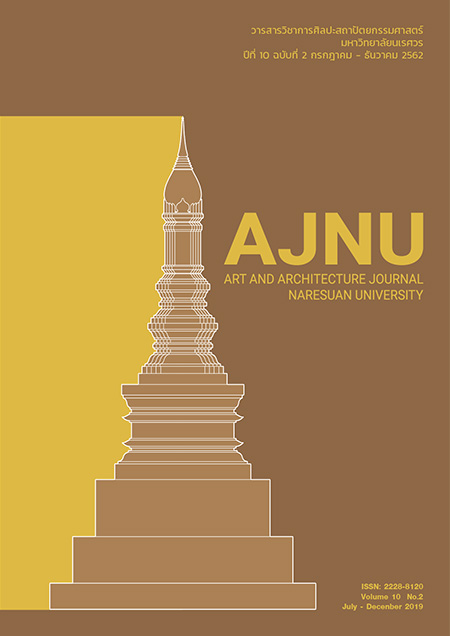The Development of Smart Phone Applications using Augmented Reality Technology in Tourism of Kamphaeng Phet Historical Park
Main Article Content
Abstract
The objectives of this research are three sections 1) Analyzing the tourist information of Kamphaengphet Historical Park. 2) Development and evaluation of an application on a smartphone using virtual reality technology for tourism in Kamphaengphet Historical Park and 3) To evaluate the satisfaction of application development on smartphone using virtual reality technology for tourism in Kamphaengphet Historical Park. The research instruments included in-depth interview participated observation questionnaires and seminar For the development of smartphone applications using virtual reality technology for tourism Kamphaengphet Historical Park there are 5 steps of development 1) To analysis of tourist information in Kamphaengphet Historical Park. 2) To develop and create smartphone applications using virtual reality technology for travel of Kamphaeng Phet Historical Park. 3) To evaluate the quality of the application on the smartphone using virtual reality technology for the Kamphaengphet Historical Park. 4) To evaluate the satisfaction of the smartphone application using virtual reality technology for tourism in Kamphaengphet Historical Park. 5) To summarize and discuss the feedback. Assessment of the quality of an application that is very well suited to an average of 4.23 and the standard deviation of 0.08. Moreover, the evaluation of tourist satisfaction is very good with an average of 4.28 and the standard deviation of 0.01
Article Details
References
เมืองเชียงใหม่เพื่อตอบสนองการใช้งานของกลุ่มนักท่องเที่ยวผู้ใช้อุปกรณ์พกพาชนิดสมาร์ทโฟนและแท็ปแล็ต.
กรุงเทพฯ: สำนักงานกองทุนสนับสนุนการวิจัย (สกว.).
ธีรารัตน์ สุระเทพ. (2557). แนวทางการนำเสนอข้อมูลประวัติศาสตร์ในอนุสรณ์สถานแห่งชาติศึกษากรณีมุสลิมในราชสำนัก.
วิทยานิพนธ์สถาปัตยกรรมศาสตรมหาบัณฑิต, มหาวิทยาลัยศิลปากร. กรุงเทพมหานคร.
ปวริศา สิทธิสาร. (2552). การศึกษาพฤติกรรมและความพึงพอใจของผู้มาเที่ยวชมนครประวัติศาสตร์พระนครศรีอยุธยา
จังหวัดพระนครศรีอยุธยา. วิทยานิพนธ์สถาปัตยกรรมศาสตรมหาบัณฑิต มหาวิทยาลัยราชภัฏพระนครศรีอยุธยา,
พระนครศรีอยุธยา.
สุการดาน กาสังข์. (2556). องค์ประกอบเชิงพื้นที่และระบบป้ายสัญลักษณ์ภายในแผนกผู้ป่วยนอกกับการค้นหาเส้นทาง.
วิทยานิพนธ์สถาปัตยกรรมศาสตรมหาบัณฑิต, มหาวิทยาลัยธรรมศาสตร์. กรุงเทพมหานคร.
สุชาดา พลาชัยภิรมย์ศิล. (2554). แนวโน้มการใช้โมบายแอพพลิเคชัน. วารสารนักบริหาร, 3(2), 110-115.
สุปิติ จันทร์ประสิทธ์. (2543). การศึกษาออกแบบระบบป้ายสัญลักษณ์มาตรฐานสำหรับกรุงเทพมหานคร. วิทยานิพนธ์
สถาปัตยกรรมศาสตรมหาบัณฑิต, มหาวิทยาลัยจุฬาลงกรณ์. กรุงเทพมหานคร.
สันติ เล็กสุขุม. (2551). โบราณสถานกับรูปแบบสันนิษฐาน.กรุงเทพฯ: บริษัท ทวีวัฒน์การพิมพ์ จำกัด.
Azuma, R. (1997). A survey of Augmented Reality Presence. Teleoperators and Virtual Environments, 6(4),
355-385.
Pilomia J (2011). User Experience in Mobile Application Development:Developer and End-user
Perceptions. Master thesis, Polytechnic University of Tampere, Finland.
Dunleavy M. (2014). BOTTARI an Augmented Reality Mobile Application to deliver Personalized and
Location-based Recommendations by Continuous Analysis of Social Media Streams. TechTrends,
58(01), 28-34.
StatcounterGlobalstats. (July 10 2018). Mobile Operating System. Retrieved August 23, 2018,
http://gs.statcounter.com/.
Yamane, Taro. (1973) Statistics: An Introductory Analysis. 3rd ed. New York: Harper & Row, Publishers, Inc.,


